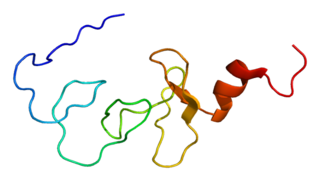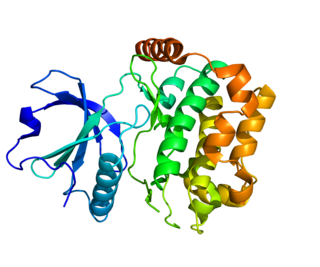
Cell division control protein 42 homolog is a protein that in humans is encoded by the CDC42 gene. Cdc42 is involved in regulation of the cell cycle. It was originally identified in S. cerevisiae (yeast) as a mediator of cell division, and is now known to influence a variety of signaling events and cellular processes in a variety of organisms from yeast to mammals.

Serine/threonine-protein kinase PAK 1 is an enzyme that in humans is encoded by the PAK1 gene.

Protein kinase C beta type is an enzyme that in humans is encoded by the PRKCB gene.

Serine/threonine-protein kinase PAK 2 is an enzyme that in humans is encoded by the PAK2 gene.

Ras-related protein Rap-1A is a protein that in humans is encoded by the RAP1A gene.

Ribosomal protein S6 kinase beta-1 (S6K1), also known as p70S6 kinase, is an enzyme that in humans is encoded by the RPS6KB1 gene. It is a serine/threonine kinase that acts downstream of PIP3 and phosphoinositide-dependent kinase-1 in the PI3 kinase pathway. As the name suggests, its target substrate is the S6 ribosomal protein. Phosphorylation of S6 induces protein synthesis at the ribosome.

Dual specificity mitogen-activated protein kinase kinase 7, also known as MAP kinase kinase 7 or MKK7, is an enzyme that in humans is encoded by the MAP2K7 gene. This protein is a member of the mitogen-activated protein kinase kinase family. The MKK7 protein exists as six different isoforms with three possible N-termini and two possible C-termini.

Rho guanine nucleotide exchange factor 7 is a protein that in humans is encoded by the ARHGEF7 gene.

Rho guanine nucleotide exchange factor 6 is a protein that, in humans, is encoded by the ARHGEF6 gene.

ARF GTPase-activating protein GIT2 is an enzyme that in humans is encoded by the GIT2 gene.

Serine/threonine-protein kinase PAK 4 is an enzyme that in humans is encoded by the PAK4 gene.

LIM domain kinase 2 is an enzyme that in humans is encoded by the LIMK2 gene.

Protein phosphatase 1A is an enzyme that in humans is encoded by the PPM1A gene.

Serine/threonine-protein kinase MRCK alpha is an enzyme that in humans is encoded by the CDC42BPA gene.

Serine/threonine-protein kinase PAK 5 is an enzyme that in humans is encoded by the PAK5 gene.

Receptor-interacting serine/threonine-protein kinase 3 is an enzyme that is encoded by the RIPK3 gene in humans.

Dual specificity protein phosphatase 4 is an enzyme that in humans is encoded by the DUSP4 gene.

Serine/threonine-protein kinase 24 is an enzyme that in humans is encoded by the STK24 gene located in the chromosome 13, band q32.2. It is also known as Mammalian STE20-like protein kinase 3 (MST-3). The protein is 443 amino acids long and its mass is 49 kDa.

Serine/threonine-protein kinase PAK 6 is an enzyme that in humans is encoded by the PAK6 gene.

CDC42 binding protein kinase beta is a protein that in humans is encoded by the CDC42BPB gene.
























